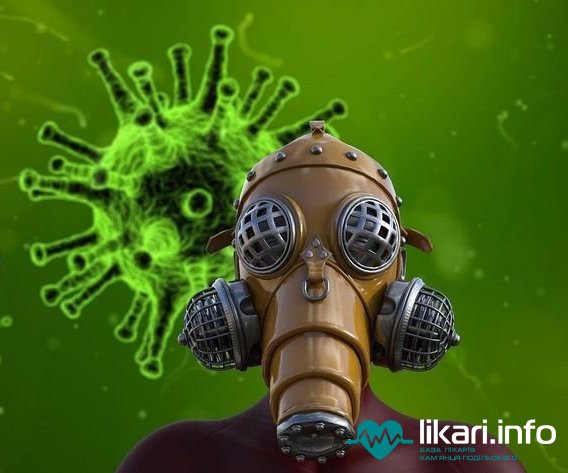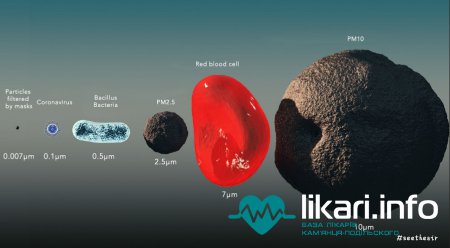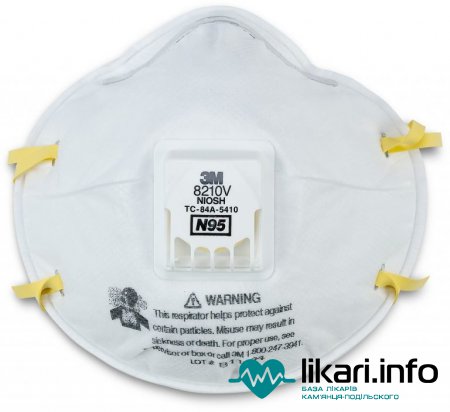To wear or not to wear medical bandages, masks, respirators during the coronavirus epidemic
- Категорія: Корисна інформація;
Human stupidity still made me write a thread about masks and do I need to wear them healthy or only sick? And what kinds of masks are there, which ones are most effective and which are not. Is there anything other than masks or is this enough? So, let's start ...
I work for a company that has been producing remedies for workers around the world for over 100 years. These are firefighters and doctors, workers in the oil and coal industry, and so on. We manufacture, ranging from disposable masks, to huge safety systems for factories.
A little about the coronavirus and its size to understand which masks filter it and what not: its average size is 0.1 microns. The image is more clearly shown in scale, the size relative to the size of the erythrocyte, the size of which is 7 microns.
Now that we know about the size of this hedgehog , we can already talk about masks that:
a) can completely filter it;
b) can filter in part as the hedgehog likes to "ride" in the air on dust particles, spores, moisture drops or even human saliva ...
Let's start with the highest protection - PAPR (Powered Air-Purifying Respirator). This device filters the inlet air by dozens of indicators, including toxic gases, viruses and bacteria. The electric motor maintains the required pressure and delivers absolutely clean air.
Next in protection against coronavirus are full-face masks with replaceable cartridges. Full face protection will prevent the virus from entering the mucous membrane of the eye, and a properly matched cartridge will protect against inhalation of the virus through the nose and mouth.
The following are already masks that do not completely protect the face (eyes open), so do not forget about eye protection with glasses - half-mask respirators (Half-Mask Respirator). But here we will dwell in more detail on the levels of protection that are suitable to counter the "hedgehog"
Remember! The highest level of protection available for respirators that can COMPLETELY filter out a coronovirus - "FFP3" just as the size of our "hedgehog" is dozens of times larger than a FFP3 respirator can filter! This is the type recommended for use in clinics.
In some countries, coronavirus pandemics have even banned retail FFP3 respirators to provide hospitals and clinics with the required volume. And it's a really working thing! Some manufacturers label FFP3 respirators and masks as well as simply "P3" - you can rest assured - it's the same FFP3 with maximum protection!
Next we go to reduce the level of protection - respirator FFP2 (medium level) and FFP1 (low level). These respirators can already "miss" our "hedgehog", but the question is only in quantity. FFP1 will miss them more. BUT! As we remember - the hedgehog attaches to the particles that these respirators ... can easily detain and filter, so the chances of not getting infected are high enough!
But if you have a choice between FFP1 and FFP2 (yes, as it is possible that FFP3 has already been banned for sale in your country), it is better to opt for FFP2. I see a lot of respiratory filters called "PM2.5" on sale. Don't be confused with "P2"! The number in the name indicates the particle size in microns that the filter can filter - a total of 2.5 microns. Remember that the size of the hedgehog is 0.1 microns and now we understand what to what.
Separately, I also want to dwell on N95 respirators - it is recommended in US clinics, but its filtering ability is particles larger than 0.3 microns, meaning "Hedgehog" can leak. I would put it on filtering capabilities between FFP2 and FFP3 (very good, but not perfect)
And now finally the "cherry on the cake" is a 3-layer surgical mask! I have heard so much about this mask before, but I would like to share with you information that may help save your life. Do not underestimate this type of mask, (especially not having others)!
Scientists at the University of Edinburgh conducted a study in which they wanted to find out how well different types of masks will cope with particle filtering in the size of 0.007 microns (remember the size of our "hedgehog" - 0.1 microns) and among others decided to try a surgical mask. And what was their surprise that a simple surgical mask delayed 80% !!! test particles! That is purely theoretically a surgical mask is able to 80% increase your chance of not getting infected by a coronavirus the way the test samples were much smaller than our "hedgehog"! (Screenshot Report)
Therefore, if you are told, "and why you and the mask - they said that it is ineffective and should only be worn by patients so that they do not spit around!" - poke them in the nose, please, here is this link with the measurement results
Even the simplest cotton scarf or buff according to measurements could stop 28% of the particles. Agree - it's better than nothing and direct contact with the virus!
Doctors have the notion of "viral load" (whoever you want to find on wikipedia definition) - the fewer copies of the virus get into the body, the more effective the immune system can handle the task. In other words, kissing an infected person is not the same as inhaling 1 particle
So don't listen to anyone - protect yourself and your family with any type of mask available to you. Don't be afraid to look stupid in a mask - look dead worse!
Update! I see a lot of questions like:
a) how many can wear masks?
b) can they be reused ?;
c) can they be washed and sterilized? Let's try to clarify these sore questions so as not to answer each one individually as many of you, and I'm alone
a) FFP1-FFP3 respirators are designed to work efficiently for 4-6 hours. The maximum permissible time of use is 8 hours, but keep in mind that after 6 hours the efficiency drops rapidly! After use, carefully remove what is not attached to the outer ... surface and recycle. Surgical mask 3-layer - in conditions of viral danger, the working time is up to 2 hours! After 2 hours, carefully remove and dispose of!
b) Some FFP1-FFP3 respirators are marked with the letter "R" (eg FFP3 R) - this means that the respirator may be reused, BUT! - this is not for use with a virus threat! It means working with asbestos, for example - you left the work area, took off your respirator, had lunch, returned to work and put on your respirator again. All. With a virus threat, you can reuse the respirator! Removed and disposed of! With surgical masks it's even easier - they are disposable! Removed and disposed of, took a new one!
c) many ask "why you can't wash and sterilize respirators like in the picture?". The answer lies in their principle of operation - the electrostatic effect. It is not just a "sieve", but a sieve with some kind of magnetic properties that attract particles to the fibers.
The same effect is used in kitchen hoods (incidentally). When the respirator is moistened, the electrostatic effect is gradually lost and the efficiency drops. Therefore, it is NOT possible to operate respirators in any case!
Now about sterilization - we have already found out that when wetting the properties of the respirator are lost, and during breathing, we moisten it with exhalation, so here the issue is no longer in sterilization, but because it just does not make sense, since the respirator is no longer such effective!
After all, to all those who still believe that "masks should be worn only to the sick" - if you are told to go into the ward with an infected person and offered to wear a mask - will you refuse, as it is "ineffective"? Or dress? I personally did not see doctors without masks in clinics. And you?
The text of the article and the photo are taken from the page on twitter by @ Pasichnik84










